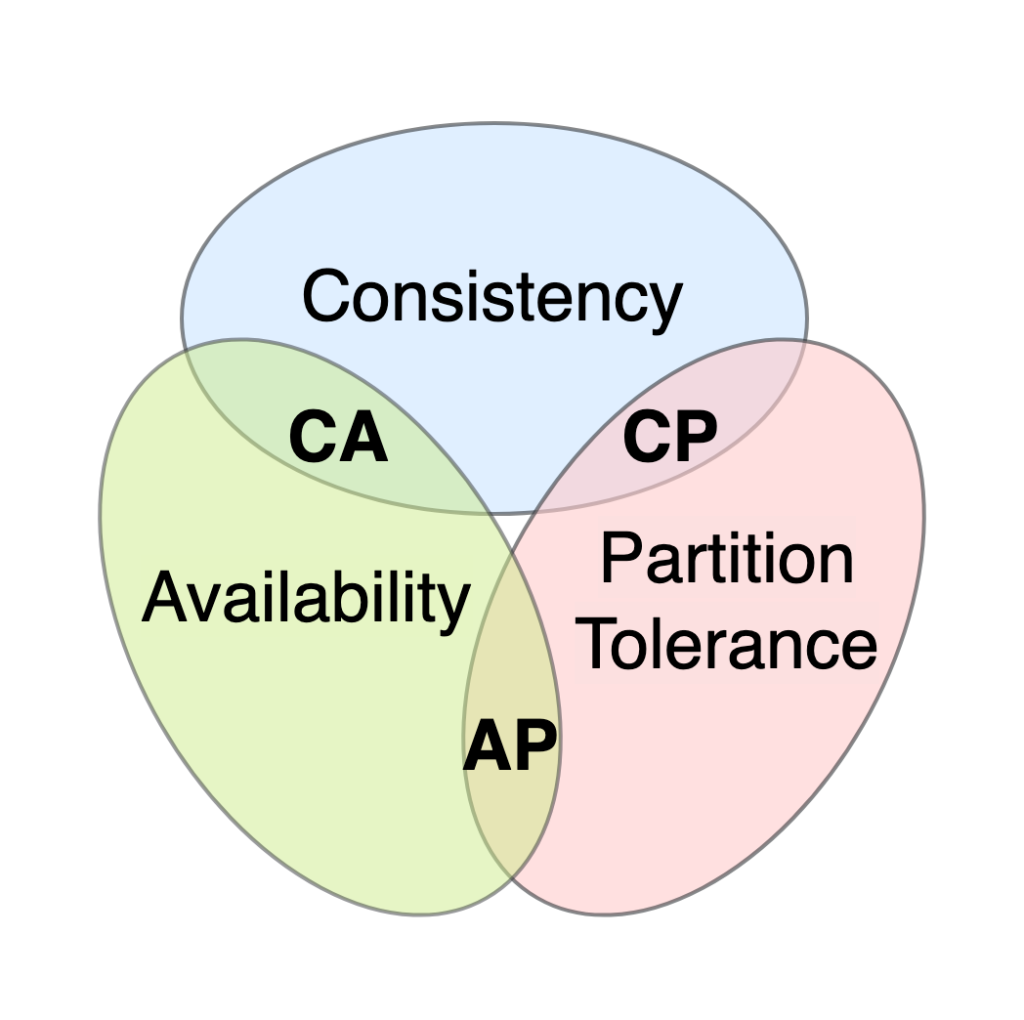
The CAP theorem, also known as Brewer’s theorem, is a fundamental principle in the design of distributed systems. Introduced by Eric Brewer in 2000, it states that a distributed system can only guarantee two out of the following three properties simultaneously: Consistency, Availability, and Partition Tolerance (CAP). This theorem has profound implications for how we design and scale distributed systems.
The Three Pillars of CAP
- Consistency ©
- Definition: All nodes in the system see the same data at the same time. When data is written to one node, it must be immediately replicated to all other nodes before the write is considered successful.
- Impact: Ensures data accuracy and reliability, but can lead to delays in response times, especially in large-scale systems.
- Availability (A)
- Definition: Every request receives a response, even if some nodes are down. The system remains operational and responsive.
- Impact: Enhances user experience by ensuring the system is always available, but may lead to inconsistencies in data during network partitions.
- Partition Tolerance (P)
- Definition: The system continues to function despite network partitions or communication breakdowns between nodes.
- Impact: Essential for maintaining system operations in the face of network failures, but requires trade-offs between consistency and availability.
Trade-offs and Design Considerations

The CAP theorem forces system designers to make trade-offs based on the specific needs of their applications. Here are some common scenarios:
- CP Systems (Consistency and Partition Tolerance)
- Example: Traditional relational databases like PostgreSQL.
- Design Focus: Prioritize data consistency and tolerate network partitions, but may sacrifice availability during failures.
- Use Case: Financial systems where data accuracy is critical.
- AP Systems (Availability and Partition Tolerance)
- Example: NoSQL databases like Cassandra.
- Design Focus: Ensure high availability and partition tolerance, but may accept eventual consistency.
- Use Case: E-commerce platforms where uptime is crucial.
- CA Systems (Consistency and Availability)
- Example: Not feasible in distributed systems due to the inevitability of network partitions.
- Design Focus: Typically found in single-node systems or tightly coupled clusters.
Scaling Distributed Systems with CAP in Mind
When scaling distributed systems, understanding the CAP theorem helps in making informed architectural decisions:
- Data Partitioning and Replication
- Strategy: Distribute data across multiple nodes to balance load and ensure redundancy.
- Impact: Enhances availability and partition tolerance but requires careful management to maintain consistency.
- Eventual Consistency Models
- Strategy: Allow temporary inconsistencies with the guarantee that all nodes will eventually converge to the same state.
- Impact: Improves availability and partition tolerance, suitable for applications where immediate consistency is not critical.
- Consensus Algorithms
- Strategy: Use algorithms like Paxos or Raft to achieve consensus among nodes.
- Impact: Ensures consistency and partition tolerance but can impact availability during network partitions.
- Hybrid Approaches
- Strategy: Combine different consistency models based on specific application requirements.
- Impact: Provides flexibility in balancing consistency, availability, and partition tolerance.
Real World Examples
Content Delivery Networks (CDNs): CDNs focus on providing efficient content delivery and prioritize Availability and Partition Tolerance (AP systems). CDNs replicate and distribute content across multiple nodes globally to reduce latency and improve user experience. While consistency is desirable, CDN systems can tolerate temporary inconsistencies across nodes, ensuring that users can access content quickly and reliably.
Social Media Platforms: Social media platforms, such as Facebook and Twitter, often prioritize Availability and Partition Tolerance (AP systems). These platforms aim to provide a seamless user experience, allowing users to post, share, and interact with content in real-time, even in the presence of network partitions. While consistency is desirable, social media platforms can tolerate temporary inconsistencies, such as delayed updates or discrepancies in user feeds, as long as the system remains highly available.
Financial Systems: In financial systems, such as banking or stock trading applications, maintaining strong Consistency (CP systems) is of utmost importance. These systems require strict synchronization and ensure that all transactions are processed consistently across all nodes, even during network partitions. Ensuring data consistency is critical to prevent any discrepancies or inconsistencies in financial transactions that could have severe consequences.
E-commerce Platforms: E-commerce platforms, like Amazon or eBay, often employ a blend of Consistency and Availability (CA systems). These platforms aim to provide a consistent view of product catalogs, prices, and inventory across all nodes while ensuring that the system remains highly available. Temporary unavailability during network partitions may be acceptable, but maintaining data consistency across the platform is crucial for accurate product information and order processing.
IoT Systems: Internet of Things (IoT) systems, where numerous devices communicate and exchange data, often prioritize Availability and Partition Tolerance (AP systems). IoT systems deal with large volumes of data generated by devices in real-time. Prioritizing availability allows the system to handle device failures or network disruptions without affecting the overall operation. In certain cases, IoT systems may choose eventual consistency to handle data synchronization and handle network partitions.
